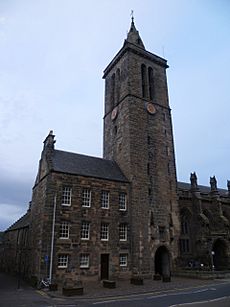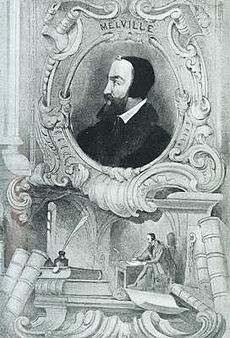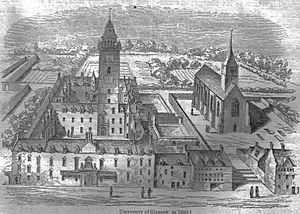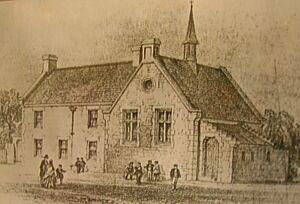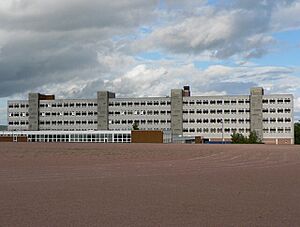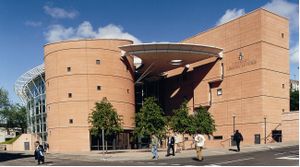History of education in Scotland facts for kids
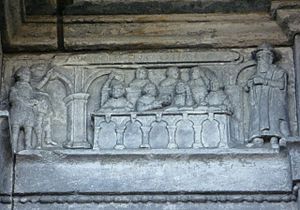
The history of education in Scotland is a long and interesting journey. It started way back in the Middle Ages with church schools and grammar schools for boys. By the late 1400s, schools also began to appear for girls. Scotland even got its first universities in St Andrews, Glasgow, and Aberdeen. A law called the Education Act 1496 made it compulsory for sons of important landowners to go to grammar schools. This helped more wealthy people learn to read and write.
Later, the Scottish Reformation brought big changes. Church choir schools closed, but parish schools grew. Universities also reformed and expanded. In the 1600s, new laws made sure every parish had a school. These schools were often looked after by local church groups called presbyteries. This system led to a belief that even poor boys could get a good education and become successful. Scotland's universities helped the country become a major player in the Age of Enlightenment in the 1700s, with famous thinkers like David Hume and Adam Smith.
In the 1800s, new challenges like factories and people moving around changed the school system. It was then reorganized and expanded. This created a national system of free basic education, paid for by the state, with common exams. Scottish universities also became important learning centers and started letting women study from 1892. In the 1900s, more Scottish teenagers went to secondary school, especially girls. The Scottish government took more control over education, moving its main office to Edinburgh in 1939. After 1999, when Scotland gained more self-governance, the Scottish Executive made big changes, like getting rid of university tuition fees.
Contents
Education in the Middle Ages
In early medieval Scotland, most learning was passed down by talking, not by reading or writing. There were poets, musicians, and historians called filidh who shared knowledge in Gaelic. Later, bards took over this role, especially in the Highlands. They often trained in special bardic schools. Much of their work was never written down.
When Christianity arrived, Latin became important for scholars and writing. Monasteries were places of knowledge. They often ran schools and taught a small group of educated people. These people were vital for creating and reading documents in a society where most couldn't read.
In the High Middle Ages, new types of schools appeared: song schools and grammar schools. These were usually connected to cathedrals or churches and were common in growing towns. By the end of the Middle Ages, grammar schools were in all main towns. Early examples include the High School of Glasgow (1124) and the High School of Dundee (1239). There were also smaller "petty schools" in rural areas, offering basic education. Some monasteries, like Kinloss Abbey, also taught more students.
These schools mostly taught boys. However, by the late 1400s, Edinburgh had schools for girls, sometimes called "sewing schools." Wealthy families also hired private tutors. The focus on education grew, leading to the Education Act 1496. This law said that all sons of important landowners must go to grammar schools to learn "perfect Latin." This helped more wealthy men become literate, but most people, especially women, still couldn't read or write.
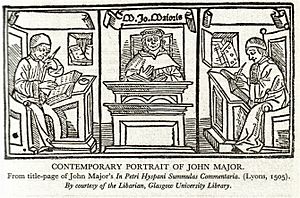
Before the 1400s, Scots who wanted to go to university had to travel to England or Europe. Over 1,000 Scots went abroad for their studies between the 1100s and 1410. One very important thinker was John Duns Scotus, who studied in Oxford, Cambridge, and Paris. He greatly influenced religious ideas in the late Middle Ages.
During the Wars of Independence, English universities were often closed to Scots. So, more Scots went to European universities. Some Scottish scholars even became teachers there. This changed when Scotland founded its own universities: the University of St Andrews in 1413, the University of Glasgow in 1451, and the University of Aberdeen in 1495. At first, these universities trained church leaders. But more and more laymen (people not in the church) started attending. This helped them get important jobs in government and law.
Scottish scholars continued to travel abroad, bringing new ideas like humanism back to Scotland. For example, Hector Boece, who studied in Paris, became the first head of the new University of Aberdeen in 1497. These connections helped Scotland join the wider European world of learning.
Impact of the Reformation
Protestant reformers wanted everyone to be educated, not just for good citizenship, but to be "godly" people. In 1560, the First Book of Discipline suggested a school in every parish. However, there wasn't enough money for this. In towns, old schools continued, and new ones became reformed grammar schools or parish schools. Schools got money from the church, local landowners, town councils, and parents who could pay. Church groups checked the teaching quality and religious beliefs.
There were also many "adventure schools" that were not officially regulated. These sometimes met local needs or took students away from official schools. Outside of town schools, teachers often had other jobs, like minor church roles. Good schools taught religious lessons, Latin, French, classic literature, and sports.
In 1616, a law said every parish should have a school "where convenient." The Parliament of Scotland confirmed this in 1633, adding a tax on landowners to pay for schools. Another law in 1646 fixed a loophole, making the funding stronger. Even though things changed after the English Restoration, new laws in 1696 brought back the strong school system. This aimed to have a school in every parish. In rural areas, landowners had to provide a schoolhouse and pay a teacher. Ministers and local church groups watched over the education. By the late 1600s, most of the Lowlands had parish schools. But the Highlands still lacked basic education in many places.
People at the time often thought women were less intelligent. However, after the Reformation, there was a desire for women to be morally responsible, especially as wives and mothers. This meant they needed to understand the catechism and read the Bible. But most people, even those who supported girls' education, thought they shouldn't get the same academic learning as boys. Poorer girls benefited from the new parish schools, but they were usually fewer in number than boys. They were often taught separately, for less time, and at a lower level. They learned reading, sewing, and knitting, but often not writing. By 1750, about 85% of women couldn't sign their names, compared to 35% of men. However, many noblewomen were well-educated, like Mary, Queen of Scots.
After the Reformation, Scottish universities changed a lot. Andrew Melville, a brilliant linguist and philosopher, returned from Geneva and became head of the University of Glasgow in 1574. He brought new ideas, focusing on logic, languages, and sciences. He introduced specialist teachers, replacing the old system where one tutor taught everything. Greek became compulsory in the first year, followed by other ancient languages. Glasgow, which might have been struggling, saw many new students arrive.
Melville also helped rebuild Marischal College in Aberdeen. In 1580, he became head of St Mary's College, St Andrews, to bring similar reforms there. The University of Edinburgh grew from public lectures started in the 1540s. It became a university in 1582. These changes revitalized all Scottish universities, making their education as good as any in Europe.
During the time of the Commonwealth, universities got more money. This allowed them to complete buildings, like the college in Glasgow. Universities were still mainly for training clergy. After the Restoration, there were some purges, but many intellectual advances remained. The five Scottish universities recovered, offering a high-quality education in economics and science. This helped them become major centers for medical education and put Scotland at the forefront of Enlightenment thinking.
Eighteenth Century
The many schools led to a belief in the 1800s called the "democratic myth." This idea was that many "lads of parts" (clever boys) could rise up through the system to important positions. It also claimed that more Scots could read than people in England. However, historians now know that very few boys actually became successful this way. Also, literacy wasn't much higher than in other countries. Education in parish schools was basic, short, and not compulsory.
Still, Scotland gained a lot from its well-developed university system. Scottish thinkers started questioning old ideas. With Scotland's links to France, which was experiencing the the Enlightenment, Scots developed a unique, practical form of humanism. Important thinkers from this time include Francis Hutcheson, a philosophy professor at Glasgow University. He helped develop ideas like Utilitarianism. His students, David Hume and Adam Smith, shaped modern ideas about science and religion.
By the 1700s, many poorer girls learned in "dame schools." These were informal schools run by widows or single women. They taught reading, sewing, and cooking. For aristocratic girls, education included basic reading, writing, math, needlework, cooking, and managing a household. Good manners and religious devotion were also important.
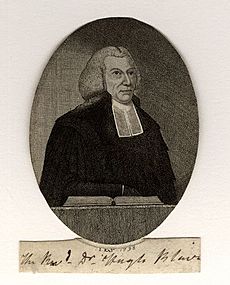
In the Scottish Highlands, distance and isolation were problems. Most people spoke Gaelic, which few teachers understood. The Kirk's parish schools were helped by the Society in Scotland for Propagating Christian Knowledge (SSPCK), started in 1709. Their goal was to teach English and reduce Roman Catholicism, which was linked to rebellious groups. Although some SSPCK schools taught the Bible in Gaelic, their overall effect contributed to the decline of Highland culture.
Throughout the late 1700s, schools and universities also benefited from a strong publishing industry in the Lowlands. This industry printed textbooks and other learning tools that helped students learn.
In the 1700s, Scotland's universities changed from small local places to major intellectual centers. They became key to Scottish identity and were seen as important for democracy and social progress. New professorships in medicine were created. Edinburgh's medical school, founded in 1732, became very famous. By the 1740s, it was a leading medical center in Europe and the Atlantic world.
Access to Scottish universities was probably more open than in England, Germany, or France. It was cheaper to attend, and students came from more parts of society. Poorer students got help from scholarships (bursaries) to train for the clergy. Students could live cheaply in town, often unsupervised. The system was flexible, and the curriculum became modern, focusing on philosophy and science. This helped Scotland make a huge contribution to the European Enlightenment.
Many key figures of the Scottish Enlightenment were university professors. They developed their ideas in lectures. These included Francis Hutcheson, whose ideas influenced David Hume (a major philosopher) and Adam Smith. Smith's book, The Wealth of Nations (1776), is considered the first work of modern economics. Hugh Blair, a minister and professor at Edinburgh, wrote famous sermons and lectures. The Scottish Enlightenment covered many areas, from ideas and economics to science, with figures like William Cullen (physician and chemist) and James Hutton (the first modern geologist).
Nineteenth Century
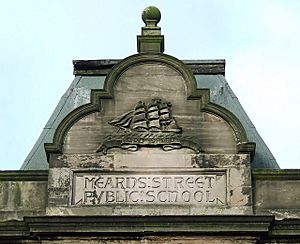
The growth of factories, cities, and a major church split (the Disruption of 1843) weakened the old parish school system. Many teachers joined the new Free Church. By 1847, over 500 teachers were paid by the Free Church, and over 44,000 children were taught in their schools.
To help the parish system, Sunday Schools became popular. Started in the 1780s, all religious groups adopted them in the 1800s. By the 1830s and 1840s, these expanded to include mission schools, ragged schools (for very poor children), and improvement classes. These were open to all Protestants and aimed at the growing working classes in cities. By 1890, Baptists had more Sunday schools than churches, teaching over 10,000 children. This number doubled by 1914.
From 1830, the government started giving money for school buildings. By 1846, it was directly funding schools. In 1872, Scotland moved to a system like England's, with state-funded, mostly free schools run by local school boards. The main administration was handled by the Scotch (later Scottish) Education Department in London. Education became compulsory for children aged five to thirteen. Many new board schools were built. Larger city school boards created "higher grade" (secondary) schools, which were cheaper than the old burgh schools.
The Scottish Education Department introduced a Leaving Certificate Examination in 1888 to set national standards for secondary education. In 1890, school fees were abolished. This created a state-funded national system of free basic education with common exams.
At the start of the 1800s, Scottish universities had no entrance exam. Students usually entered at 15 or 16, studied for only two years, chose their lectures, and left without a degree. After two official investigations and new laws in 1858 and 1889, the curriculum and graduation system changed. This was to meet the needs of the growing middle classes and professions. Entrance exams, similar to the School Leaving Certificate, were introduced. The average age of entry rose to 17 or 18.
Standard degrees in arts offered 3-year ordinary and 4-year honours degrees. Separate science departments moved away from the compulsory Latin, Greek, and philosophy of the old arts degree. The University of Glasgow became a leader in British higher education. It provided education for young people from city and business families, as well as the upper class. It prepared students for careers in government, law, medicine, education, and the church. A smaller group studied science and engineering.
St Andrews was the first Scottish university to admit women. It created the Lady Licentiate in Arts (LLA), which was very popular. From 1892, Scottish universities could officially admit and graduate women. The number of women at Scottish universities steadily increased until the early 1900s.
Twentieth Century
The Scottish education system changed and grew a lot in the 1900s. In 1918, Roman Catholic schools joined the state system. But they kept their religious character, allowing priests access and requiring staff to be approved by the Church. The school leaving age was raised to 14 in 1901. Although plans to raise it to 15 in the 1940s didn't happen, more and more students stayed in school past elementary education. The leaving age was finally raised to 16 in 1973.
As a result, secondary education grew significantly between the two World Wars, especially for girls. Girls stayed in full-time education in increasing numbers throughout the century. New qualifications were created to match changing goals and the economy. The Leaving Certificate was replaced by the Scottish Certificate of Education Ordinary Grade ('O-Grade') and Higher Grade ('Higher') qualifications in 1962. These became the basic entry requirements for university. The education system also became more focused on Scotland. The education ministry partly moved north in 1918, and its headquarters finally moved to Edinburgh in 1939.
In the first half of the 1900s, Scottish universities fell behind those in England and Europe in terms of student numbers and investment. The decline of traditional industries between the wars made it harder to attract students. While English universities saw student numbers rise by 19% between 1924 and 1927, numbers fell in Scotland, especially among women. Also, spending in English universities rose by 90%, but in Scotland, it was less than a third of that.
In the 1960s, the number of Scottish universities doubled. Dundee separated from St Andrews. Strathclyde and Heriot-Watt grew from existing colleges. Stirling opened as a completely new university in 1966. After 1992, five more institutions that already awarded degrees became universities. These were Abertay, Glasgow Caledonian, Napier, Paisley (now the University of the West of Scotland), and Robert Gordon. In 2001, the University of the Highlands and Islands was created by joining 13 colleges and research places in the Highlands and Islands.
After Scotland gained more self-governance in 1999, the new Scottish Executive created an Education Department and an Enterprise, Transport and Lifelong Learning Department. One big difference from England was the abolition of student tuition fees in 1999. Instead, Scotland kept a system of student grants based on financial need.
The current education system
For more details on how education works in Scotland today, see Education in Scotland.
See also
- History of schools in Scotland
- Gaelic medium education in Scotland
- List of further and higher education colleges in Scotland


